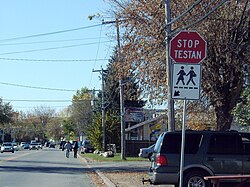Kahnawake
Caughnawaga | |
|---|---|
| Kahnawake First Nations Reserve No. 14 | |
 | |
 Location of Kahnawake, outside of Roussillon RCM. | |
| Coordinates: 45°25′N 73°41′W / 45.417°N 73.683°W | |
| Country | Canada |
| Province | Quebec |
| Region | Montérégie |
| RCM | Roussillon Within RCM, but unassociated |
| Electoral Districts Federal | La-Prairie |
| Provincial | Châteauguay |
| Government | |
| • Type | Band council |
| • Grand Chief | Kahsennenhawe Sky-Deer |
| • Federal MP(s) | Alain Therrien (BQ) |
| • Quebec MNA(s) | Pierre Moreau (PLQ) |
| Area | |
| • Land | 50.41 km2 (19.46 sq mi) |
| Population (2022)[5] | |
| • Total | 7,965 |
| • Pop 2006-2011 | N/A |
| • Dwellings | N/A |
| Demonym | Kahnawakehro:non |
| Time zone | UTC−05:00 (EST) |
| • Summer (DST) | UTC−04:00 (EDT) |
| Postal code(s) | |
| Area code | 450 |
| Highways | |
| Website | www.kahnawake.com |
The Kahnawake Mohawk Territory (French: Territoire Mohawk de Kahnawake, pronounced [ɡahnaˈwaːɡe] in the Mohawk language, Kahnawáˀkye[6] in Tuscarora) is a First Nations reserve of the Mohawks of Kahnawá:ke on the south shore of the Saint Lawrence River in Quebec, Canada, across from Montreal. Established by French Canadians in 1719 as a Jesuit mission, it has also been known as Seigneury Sault du St-Louis, and Caughnawaga (after a Mohawk village in the Mohawk Valley of New York). There are 17 European spelling variations of the Mohawk Kahnawake.
Kahnawake's territory totals an area of 48.05 km2 (18.55 sq mi). Its resident population numbers slightly above 8,000, with a significant number living off reserve. Its land base today is unevenly distributed due to the federal Indian Act, which governs individual land possession. It has rules that are different from those applying to Canadian non-reserve areas. Most Kahnawake residents originally spoke the Mohawk language, and some learned French when trading with and allied with French colonists. Together with most of four Iroquois nations, including the Mohawk, they allied with the British government during the American Revolutionary War and the Lower Canada Rebellion. They have since become mostly English speaking.
Although people of European descent traditionally refer to the residents of Kahnawake as Mohawk, their autonym is Kanien’kehá:ka (the "People of the Flint"). Another meaning is "those who speak [the language] Kanien'kéha"). The Kanien’kehá:ka were historically the most easterly nation of the Haudenosaunee (Six Nations Iroquois Confederacy) and are known as the "Keepers of the Eastern Door". They controlled territory on both sides of the Mohawk River and west of the Hudson River in present-day New York, where they protected other parts of the confederacy to the west against invasion by tribes from present-day New England and the coastal areas.
Kahnawake is one of several self-governing Kanien’kehá:ka territories of the Mohawk Nation within the borders of Canada, including Kanesatake on the north shore of the Saint Lawrence River northwest of Montreal; Tyendinaga in Ontario; Akwesasne, which straddles the borders of Quebec, Ontario and New York across the Saint Lawrence River; and the Six Nations of the Grand River in Ontario north of Lake Erie. In the late 18th and early 19th centuries, the British considered Kahnawake one of the Seven Nations of Canada.
The name is derived from the Mohawk word kahnawà:ke, meaning "place of the rapids", referring to their major village Caughnawaga near the rapids of the Mohawk River in what is today central New York. When converted Catholic Mohawk moved to the Montréal area, they named the new settlement after their former one.[7] The proximity of the Lachine Rapids also influenced their naming decision.
- ^ Kahnawá:ke, Mohawk Council of. "Mohawk Council of Kahnawá:ke". www.kahnawake.com.
- ^ Riding history for Châteauguay–Saint-Constant, Quebec from the Library of Parliament
- ^ Chief Electoral Officer of Québec - 40th General Election Results: CHÂTEAUGUAY[permanent dead link]
- ^ Government of Canada, Statistics Canada (13 March 2007). "Statistics Canada: 2006 Community Profiles". www12.statcan.gc.ca.
- ^ "Indigenous communities in Quebec". 15 October 2021.
- ^ Rudes, B. Tuscarora English Dictionary Toronto: University of Toronto Press, 1999
- ^ Bright, William (2004). Native American placenames of the United States. University of Oklahoma Press. p. 84. ISBN 978-0-8061-3598-4. Retrieved 11 April 2011.

